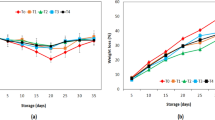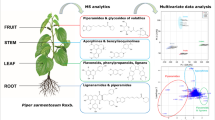Abstract
Coconut inflorescence sap is a phloem sap collected from the unopened coconut spadix. A new ‘coco-sap chiller method’ (CSCM) is developed to collect fresh and unfermented sap devoid of extraneous matter. A study was conducted to identify and compare the nutrients present in the sap collected by CSCM and the sap collected by traditional method (TM) using lime coated earthen pot, and also in the sap concentrate and coconut sugar prepared from sap collected by CSCM. Profiling of amino acids, phenolic acids, flavonoids and vitamins was also done using Ultra-Performance Liquid Chromatography/ Tandem Mass Spectrometry (UPLC coupled with TQD-MS/MS). Distinct variation in physical and biochemical properties were recorded between the sap collection methods. The sap collected by CSCM was slightly alkaline (pH 7–8), golden brown in color, sweet and delicious and rich in nutrients and zero alcoholic. While the sap collected by TM was acidic (pH below 6), oyster white in color and gave astringent smell and had about 2.32% alcohol. Sap collected by CSCM was rich in essential amino acids like lysine, threonine and histidine. A total number of thirteen phenolic acids and seven flavonoids were identified from coconut sap, sap concentrate and sap sugar. Vanilic acid, syringic acid, trans-cinnamic acid and p-hydroxy benzoic acid are the major phenolic acids and catechin, hesperitin, and myricetin are the major flavonoids identified. Vitamin C, niacin, and tocopherol are the major vitamin identified. Except few vitamins, all the nutrients present in the sap were preserved in the sap concentrate and coconut sugar. In summary, coconut sap collected by CSCM was fresh and contained numerous health promoting biochemical constituents such as phenolics, flavonoids and vitamins. Hence it can be consumed as ready to serve non-alcoholic health drink. Similarly, nutrient rich sap concentrate and coconut sugar can be prepared from fresh sap collected by CSCM without the addition of any chemicals.


Similar content being viewed by others
References
Anonymous, Neera—a treasure house of untapped potential. Ind. Coconut J. (2013)
K.B. Hebbar, M. Arivalagan, M.R. Manikantan, A.C. Mathew, C. Thamban, G.V. Thomas, P. Chowdappa, Coconut inflorescence sap and its value addition as sugar—collection techniques, yield, properties and market perspective. Curr. Sci. 109, 1411–1417 (2015)
T.P. Trinidad, A.C. Mallillin, R.S. Sagum, R.R. Encabo, Glycemic index of commonly consumed carbohydrate foods in the Philippines. J. Funct. Foods. 2, 271–274 (2000)
H. Purnomo, Sugar components of coconut sugar in Indonesia. Asean Food J. 7(4), 200–201 (1992)
Patent. Patent file No. 2425/CHE/2013 A dated 03/06/2013 and 4077/CHE/2014 A dated 05/09/2014)
K.B. Hebbar, M.R. Manikantan, P. Chowdappa, Kalparasa to boost rural economy. Ind. Hort. 62(1), 71–73 (2017)
Q. Xia, R. Li, S. Zhao, W. Chen, H. Chen, B. Xin, Y. Huang, M. Tang, Chemical composition changes of post-harvest coconut inflorescence sap during natural fermentation. Afr. J. Biotechnol. 10(66), 14999–15005 (2011)
B.B. Borse, L.J.M. Rao, K. Ramalakshmi, B. Raghavan, Chemical composition of volatiles from coconut sap (neera) and effect of processing. Food Chem. 101(3), 877–880 (2007)
O.N. Allen, Experiments in soil bacteriology (Burgess, Minneapolis, 1959)
J.P. Martin, 1950, Use of acid, rose Bengal and streptomycin in the plate method for estimating soil fungi. Soil Sci. 69, 215–232 (1950)
K.M. DuBois, A. Gilles, J.K. Hamilton, P.A. Rebers, F. Smith, Colorimetric method for determination of sugars and related substances. Anal. chem. 28, 350–356 (1956)
M. Somogyi, Notes on sugar determination. J Biol Chem. 195, 19–23 (1952)
AOAC (Association of Official Analytical Chemists), Official Methods of Analysis, Ascorbic acid, 967.21, 45.1.14 (AOAC International, Gaithersburg, 2006)
H. Meyer, The ninhydrin reaction and its analytical applications. Biochem J. 67(2), 333–340 (1957)
B. Zoecklein, K.C. Fugelsang, B. Gump, F.S. Nury, Alcohol and Extract, Wine analysis and production (Springer, New York, 1999), pp. 97–114
V.L. Singleton, R. Orthofer, R.M. Lamuela-Raventos, Analysis of total phenols and other oxidation substrates and antioxidants by means of folin-ciocalteu reagent. Methods Enzymol. 299, 265–275 (1999)
O.K. Chun, D.O. Kim, H.Y. Moon, H.G. Kang, C.Y. Lee, Contribution of individual polyphenolics to total antioxidant capacity of plums. J. Agric. Food Chem. 51, 7240–7245 (2003)
I.E.F. Benzie, J.J. Strain, The ferric reducing ability of plasma (FRAP) as a measure of ‘antioxidant power’: the FRAP assay. Anal. Biochem. 239, 70–76 (1996)
S. Moore, D.H. Spackman, W.H. Stein, Chromatography of amino acids on sulfonated polystyrene resins. Anal Chem. 30, 1185–1190 (1958)
K.P. Khalique, T.N. Lone, A.L. Pasha, Khan, amino acid digestibility of chemically treated and extruder cooked defatted rice polishing. Malays. J. Nutr. 10(2), 195–206 (2004)
H. Chen, Y. Zuo, Y. Deng, Separation, and determination of flavonoids and other phenolic compounds in cranberry juice by high-performance liquid chromatography. J. Chromatogr. A. 913, 387–395 (2001)
J. Santos, J.A. Mendiola, M.B.P.P. Oliveira, E. Ibáñez, M. Herrero, Sequential determination of fat- and water-soluble vitamins in green leafy vegetables during storage. J. Chromatogr. A 1261, 179–188 (2012)
Y. Pan, J. Li, X. Li, J. Chen, G. Bai, Determination of free amino acids in isatidis radix by HILIC-UPLC-MS/MS. Bull. Korean Chem. Soc 35(1), 197–203 (2014)
M. Arivalagan, T.K. Roy, A.M. Yasmeen, K.C. Pavithra, P.N. Jwala, K.S. Shivasankara, M.R. Manikantan, K.B. Hebbar, S.R. Kanade, Extraction of phenolic compounds with antioxidant potential from coconut (Cocosnucifera L.) testa and identification of phenolic acids and flavonoids using UPLC coupled with TQD-MS/MS. LWT Food Sci. Technol. 92, 116–126 (2018)
P. Dhar, A.B. Tayade, J. Kumar, O.P. Chaurasia, R.B. Srivastava, S.B. Singh, Nutritional profile of phytococktail from Trans-Himalayan plants. PLoS ONE 8(12), e83008 (2013)
P. Kavitha, K.S. Shivashankara, T.K. Roy, K.C. Pavithra, V.K. Rao, A.T. Sadashiva, K.V. Ravishankar, G.J. Sathish, Metabolite profiling for six ‘B’ vitamins using LC-MS in tomato genotypes at different stages of fruit maturity. J. Hortic. Sci. 10(1), 30–37 (2015)
SAS, Statistical Analysis Software System, Version 9.3 (SAS Institute, Cary, 2012)
K.B. Hebbar, A.C. Mathew, M. Arivalagan, K. Samsudeen, G.V. Thomas, Value added products from Neera. Ind. Coconut J. LVI 4, 28–33 (2013)
I.B. Thabet, H. Attia, S. Besbes, C. Deroanne, F. Francis, N.E. Drira, C. Blecker, Physicochemical and functional properties of typical tunisian drink: date palm sap (Phoenix dactylifera L.). Food Biophys. 2, 76–82 (2007)
L. Fu, B.T. Xu, X.R. Xu, R.Y. Gan, Y. Zhang, E.Q. Xia, H.B. Li, Antioxidant capacities and total phenolic contents of 62 fruits. Food Chem. 129(2), 345–350 (2011)
F.J. Hidalgo, E. Alcón, R. Zamora, Cysteine- and serine-thermal degradation products promote the formation of Strecker aldehydes in amino acid reaction mixtures. Food Res. Int. 54(2), 1394–1399 (2013)
M. Kataria, N. Kaur, R. Narula, K. Kumar, S. Kataria, N. Verma, L-asparaginase from novel source- Solanumnigrum and development of asparagine biosensor. Pharma Innov. J. 4(5), 81–84 (2015)
E. Aguayo, A. Martínez-Sánchez, A.C. Silveira, M.P. Tarazona, Effects of pasteurization and storage time on watermelon juice quality enriched with L-citrulline. Acta Hortic. 1151, 267–272 (2017)
A. Mostafa, A. Masoud, N. Mahboob, Amino acid profile as a feasible tool for determination of the authenticity of fruit juice. Adv Pharm Bull. 4, 359–362 (2014)
B. Aalbersberg, S. Rohinee, R. Praveen, Nutrient analysis of coconut toddy. Trop Sci. 37(3), 160–163 (1997)
Acknowledgements
This research was made possible by financial support from the Indian Council of Agricultural Research, and ICAR- Central Plantation Crops Research Institute, Kasaragod, Kerala, India. Authors also thankful to Director, ICAR- IIHR, Bengaluru, Karnataka, India for providing LC MS/MS facility.
Author information
Authors and Affiliations
Corresponding authors
Additional information
Publisher's Note
Springer Nature remains neutral with regard to jurisdictional claims in published maps and institutional affiliations.
Rights and permissions
About this article
Cite this article
Hebbar, K.B., Arivalagan, M., Pavithra, K.C. et al. Nutritional profiling of coconut (Cocos nucifera L.) inflorescence sap collected using novel coco-sap chiller method and its value added products. Food Measure 14, 2703–2712 (2020). https://doi.org/10.1007/s11694-020-00516-y
Received:
Accepted:
Published:
Issue Date:
DOI: https://doi.org/10.1007/s11694-020-00516-y




